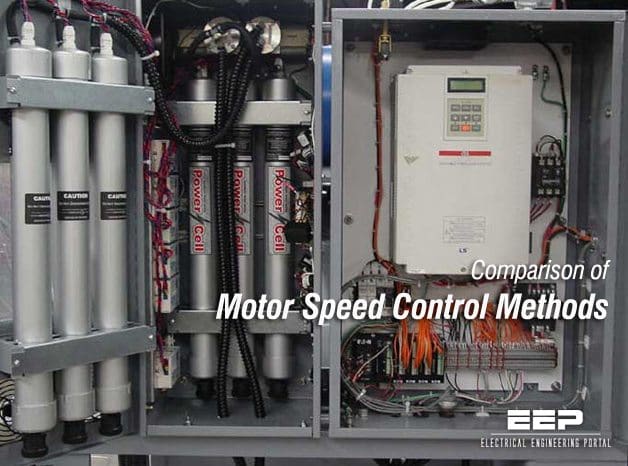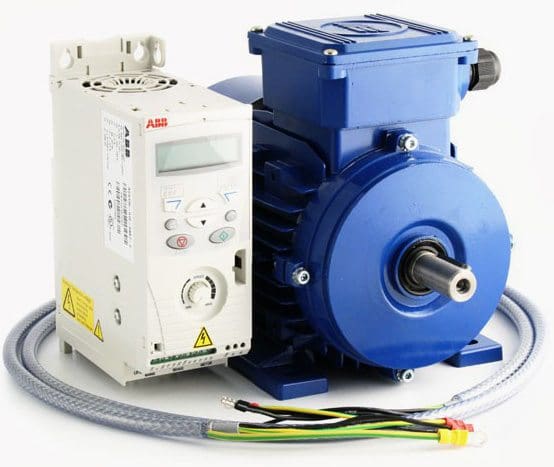
Comparison of Motor Speed Control Methods (on photo: single motor variable speed drive for three pocket washer-extractors; via edrodynawash.com)
Why motor speed control?
It is often desirable to control the motor speed, usually for reasons process control for such variables as flow or pressure. Such applications as fans and pumps often have varying output requirements, and control of the motor speed is more efficient than mechanically limiting the process output with such devices as throttling valves or dampers.
The reason for this is due to the fact that for centrifugally-based processes (such as fans and centrifugally-based pumps), the following relationships exist:
Torque = RPM2
Power = RPM3
So, for these types of processes the torque required to turn them is proportional to the square of the speed.
It is clear that motor speed control can be used to save energy by reducing wasted energy used to mechanically control the process.
Adjustable-speed drives (ASDs)
By far the most commonly-used AC motor control method is the use adjustable-speed drives. In most commercial and industrial environments these have supplanted virtually every other motor speed control method.
An adjustable-speed drive works on the principle of varying the frequency to vary the speed of the motor. Recall that from equations above the synchronous speed of a motor is a function of both the system frequency and the number of poles of the motor. By varying the frequency, the motor speed may be varied so long as the motor is equipped to dissipate the heat at reduced speeds.
Unlike soft-starting, specialized definite-purpose inverter-rated motor designs are preferred since reduced-speed operation can cause thermal issues and overspeed operation can result in safety issues.
Further, pulse-width modulated (PWM) drive outputs can cause repetitive voltage overshoots referred to as ringing, which can reduce the life expectancy of a general-purpose motor. The motor manufacturer should be consulted before applying a general-purpose motor in an adjustable-speed drive application.
Table 1- Motor starting methods summary
| Method | Advantages | Disadvantages |
| Across-the -Line | Simple, Cost-Effective | High Current Inrush High Starting Torque Abrupt Start |
| Reduced-voltage autotransformer | High output torque vs. starting current. Some Flexibility in starting characteristics due adjustable taps on autotransformers | Limited duty cycle Large equipment size due to autotransformers |
| Reduced-Voltage Resistor or Reactor | High output torque vs. starting current | Limited duty cycle Limited flexibility in starting characteristics Higher inrush current than with reduced-voltage autotransformer Large equipment size due to resistors/reactors |
| Wye-Delta | Relatively low inrush current Relatively simple starter construction Good for long acceleration times | Relatively low output torque vs. starting current Limited flexibility in starting characteristics Requires special motor construction |
| Part-Winding | Relatively Simple starter construction | Relatively low output torque vs. starting current Not suitable for frequent starts Requires special motor construction |
| Solid-state soft starter | Smooth Acceleration Low inrush current High flexibility in starting characteristics Typically offers deceleration control also Typically integrates with industrial automation infrastructure | Relatively Expensive Sensitive to power quality Heat dissipation and ambient temperature are a concern |
| Rotor Resistance | Smooth acceleration available Good flexibility in starting characteristics Can be used for speed control also | Complicated controller design Requires expensive wound-rotor motor construction |
| Adjustable Speed Drive | Smooth Acceleration Low inrush current High flexibility in starting characteristics Offers deceleration and speed control also Typically integrates with industrial automation infrastructure | Cost-prohibitive unless speed control is required also Sensitive to power quality Heat dissipation and ambient temperature are a concern Continuous harmonic currents can create power quality issues |
Various designs exist for adjustable-speed drives, however for low voltage drives the most prevalent is the voltage-source pulse-width modulated design. As its name implies, the output is pulse-width modulated to reduce the output harmonic and noise content.
The AC input to the drive is typically a diode rectifier. A simplified circuit topology for al voltage-source PWM drive is given in Figure 1 below.

Figure 1 – Voltage-source PWM adjustable-speed drive: simplified circuit topology for low voltage implementation
The output stage for the circuit in Figure 1 consists of Insulated-Gate Bipolar Transistors (IGBT’s), which are commonly used in low voltage PWM adjustable-speed drives instead of SCR’s due to their superior switching rate capability.
Due to the high switching frequencies involved and their interaction with the cable capacitance, the length of the cable runs between the output of the drive and the motor are limited, and, as mentioned above for soft-starters, power factor correction capacitors and surge capacitors should not be used at the output of an adjustable speed drive.
Also due to the high switching frequencies, common-mode noise on the grounding conductors can be an issue when these drives are employed.

AC Variable Speed Drive and IE2 Motor Kit – 1.5kW (2.0HP) 230V Single Phase (photo credit: inverterdrive.com)
On the incoming line, adjustable speed drives produce harmonics which must be taken into account in the over-all system design. This topic is addressed in a later section of this guide. Adjustable speed drives, like soft-starters, are microprocessor-based devices. Therefore, they can interface with the automation infrastructure of a facility.
With the exception of a few isolated cases, for most industrial and commercial facilities adjustable speed drives are the speed control of choice for AC motors.
Older methods //
Various other methods exist for AC motor speed control. A few of these are:
- Rotor-resistance speed control – similar to rotor-resistance starting, this method consists of varying the effective resistance in the rotor of a wound-rotor induction motor to vary the speed. Variants of this method include rotor power recovery systems using a second machine or an auxiliary solid-state rectifier and converter.
- Multi-speed motor – This type of motor is typically a squirrel-cage motor which has up to four fixed speeds.
- Primary voltage adjustment using saturable reactors – This method is only applicable to NEMA Design D motors and offers a very narrow range of speed control.
Because of the limitations of these methods and the fact that they do not fit a wide range of motors, the adjustable speed drive is typically the solution of choice for most commercial and industrial facilities.
Reference // AC Motors, motor control and motor protection - Bill Brown, P.E., Square D Engineering Services